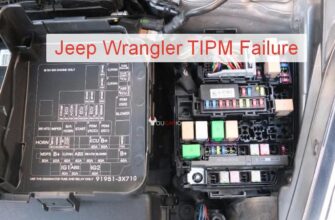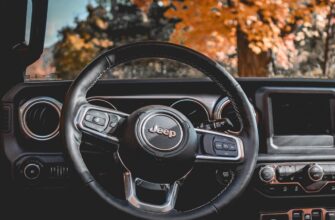Ah, the Jeep Grand Cherokee! A versatile SUV known for comfort and capability. But what happens when that comfort is interrupted by temperamental heating and air conditioning, or worse, weird clicking noises coming from deep within your dashboard? Chances are, you’re dealing with a faulty blend door actuator.
This isn’t just a minor annoyance; a bad actuator can leave you sweating in summer or freezing in winter, and the noises can drive you crazy! It’s a known pain point for many Grand Cherokee owners across various generations. So, what exactly are these little parts, and how do you know if one (or more!) is causing your HVAC headaches?
Let’s dive into the world of blend door actuators in your Jeep Grand Cherokee.
What Are Blend Door Actuators and What Do They Do?
Imagine your climate control system as a miniature air handling unit, just like in a building. Inside the dashboard’s heater box, there are flaps or “doors” that direct and mix air. Blend door actuators are the tiny electric motors responsible for moving these doors.
Directing the Airflow Ballet
These small but mighty actuators control critical functions:
- Temperature Blending: They mix hot air from the heater core and cold air from the AC evaporator to get the exact temperature you set. In dual-zone systems, separate actuators often control the driver and passenger side temperatures.
- Mode/Direction: They change where the air comes out – dashboard vents, floor vents, defrost.
- Recirculation: They open or close the door that determines if the system pulls in fresh outside air or recirculates cabin air.
Think of them as tiny robotic stagehands, constantly adjusting the scenery (airflow) behind the scenes to keep you comfortable.
There’s More Than One!
It’s important to know there isn’t just one blend door actuator in your Grand Cherokee. Depending on your vehicle’s year and options (like dual-zone climate control), there could be anywhere from 3 to 5 or even more actuators, each controlling a specific function in a specific location behind the dash.
Symptoms of a Failing Blend Door Actuator
How do these little robots tell you they’re giving up? They usually do it through bad airflow or annoying sounds.
HVAC Output Problems
These are the most direct signs that air isn’t being directed or mixed correctly:
- Incorrect Temperature: You set the temperature to cold, but only get hot air (or vice-versa). This might affect only the driver’s side, passenger’s side, or the whole cabin if it’s a main blend door.
- No Airflow to Certain Vents: Air only comes out of the defrost vents, or you can’t get air to the floor or face vents, no matter the setting.
- Stuck on Recirculation: You can’t switch between fresh air and recirculated air, or it defaults to one setting.
- Temperature or mode changes are slow, intermittent, or simply don’t happen.
“My Grand Cherokee’s AC suddenly only blew hot air on the driver’s side, but the passenger side was fine. After some digging online, it pointed to the driver’s side blend door actuator failing.” – Sarah P., Jeep Owner
Sometimes HVAC issues can come with weird smells too. While blend door actuators themselves don’t usually smell, problems in the system can interact. You might find our guide on Funky Smell From Your Car’s AC interesting, though it covers a different type of HVAC problem.
Strange Noises from the Dash
This is arguably the most common and recognizable symptom of a failing actuator motor.
- Clicking or Ticking: A rapid clicking, ticking, or thumping sound coming from behind your dashboard, especially when you first start the car, change the temperature, change the airflow mode, or turn the system off. This sound is often the actuator motor’s gears stripping or failing as it tries and fails to move the door.
“That clicking noise! It started subtly, then got louder and more frequent. Every time I started my Jeep Grand Cherokee, it was click-click-click from behind the radio. Knew it was a blend door actuator right away.” – Mike R., Experienced with Jeeps
Why Do These Actuators Fail?
Given their location and constant movement, actuators are prone to wear.
Plastic Gear Wear is Common
Inside these small electric motors are plastic gears. Over thousands of cycles of opening and closing doors, these gears can strip, crack, or break, leading to the clicking noise and inability to move the door.
Electrical Motor Failure
Like any small electric motor, the actuator’s motor can simply burn out or fail over time.
Control Module Glitches
Less often, the actuator itself might be fine, but the command signal from the main HVAC control module is faulty or corrupt, causing the actuator to behave erratically or not at all.
Physical Obstruction
Rarely, a foreign object (like a dropped pen or piece of debris) could fall into the vents and physically block a blend door’s movement, causing the actuator to strain and fail.
Troubleshooting & Potential DIY Fixes (Start Here!)
Before you pull your dashboard apart, there are a few troubleshooting steps you can try.
Listen Carefully to Pinpoint the Sound
If you hear clicking, try changing temperature settings from cold to hot and back, or switching airflow modes (vents, floor, defrost) while listening closely to the dash. The clicking sound should get louder as the faulty actuator tries to move. This can help you narrow down which side of the dash or which specific actuator is failing.
The Calibration/Reset Trick
Sometimes, an actuator simply loses its “home” position or gets stuck due to a temporary electronic glitch. Many vehicles have a calibration procedure.
- Common Method: Disconnecting the battery for 15-30 minutes can sometimes reset the HVAC control module and force the actuators to recalibrate when power is restored. Other vehicles might have a specific button sequence (check Jeep forums for your specific year/model).
- Why It Might Work: This can clear temporary software issues that are confusing the actuator’s position. It’s worth a try before replacing parts.
If you’re dealing with other odd electronic behaviors in your Jeep, you might find our guides on Jeep Grand Cherokee Immobilizer Reset or even the broader Jeep Wrangler TIPM Failure Symptoms helpful for context on how Jeep’s electronic systems can sometimes act up.
Identifying Which Actuator
As mentioned, your Grand Cherokee has multiple actuators. The specific symptom usually points to which one is the problem:
- No heat/AC on one side in a dual-zone system = Driver or Passenger side blend door actuator.
- Cannot switch modes (e.g., stuck on defrost) = Mode door actuator.
- Cannot switch recirculation = Recirculation actuator.
Locating the exact faulty actuator for your specific year and model often requires consulting service manuals or searching dedicated Jeep Grand Cherokee forums where owners share diagrams and locations.
Replacing a Blend Door Actuator (Know What You’re Getting Into)
Replacing a blend door actuator is a common repair, but the difficulty varies wildly depending on which actuator is faulty.

Location, Location, Location!
Some actuators are relatively accessible near the glove box or under the steering column. Others are buried deep within the dashboard, requiring significant disassembly of panels, the radio, or even the entire dash structure. This is where the repair difficulty goes from moderate DIY to “maybe I should call a pro.”
“Replacing the blend door actuator on the passenger side was pretty easy on my Grand Cherokee, just had to drop the glove box. But the driver’s side one? Forget about it! It was buried and looked like a nightmare. Paid a mechanic for that one.” – Chris W., DIY Selector
DIY Difficulty
If you’re comfortable removing interior panels, have the right tools (screwdrivers, trim removal tools), and can clearly identify the faulty actuator’s location, some actuators are definitely DIY-friendly. However, if the job requires disconnecting refrigerant lines (which it usually doesn’t for just actuators, but worth noting for HVAC work in general) or removing major dash components, it quickly becomes a job for a professional.
When to Call a Professional
If you’re unsure about which actuator is bad, uncomfortable with removing interior trim, or the actuator is in a hard-to-reach location requiring extensive dashboard disassembly, it’s best to call a qualified mechanic. They have the experience and tools to do the job efficiently without breaking delicate plastic panels.
Frequently Asked Questions (FAQ)
Q: How many blend door actuators are in a Jeep Grand Cherokee?
A: The exact number varies by model year and options (like manual vs. automatic climate control, single vs. dual zone). Most Grand Cherokees have at least 3 to 5 actuators, potentially more in fully loaded trims.
Q: Can I drive my Jeep Grand Cherokee with a bad blend door actuator?
A: Yes, generally you can still drive the vehicle safely with a faulty blend door actuator. The issue primarily affects the comfort of your climate control (temperature, airflow direction) and may cause clicking noises. It does not typically impact the vehicle’s safety or drivability, unless it somehow causes a major electrical short (very rare).
Q: Will replacing the actuator fix the clicking noise?
A: Yes, in most cases where the clicking is caused by a stripped gear or failing motor inside the actuator, replacing the faulty actuator will eliminate the clicking noise.
Q: Do blend door actuators need to be calibrated after replacement?
A: Often, yes. Many modern climate control systems require a calibration procedure after replacing an actuator so the system “learns” the actuator’s range of motion. Sometimes this happens automatically after reconnecting the battery or turning the system on/off a few times. Other times, it might require a scan tool that can perform the HVAC system calibration. Consult your service manual or online resources for your specific year.
Q: Are aftermarket blend door actuators reliable?
A: Quality can vary significantly with aftermarket parts. While some aftermarket actuators are perfectly fine and much cheaper than OEM (Original Equipment Manufacturer) parts, others may fail prematurely or not function correctly. Reading reviews and choosing a reputable brand is important if you go the aftermarket route.
Conclusion
Blend door actuator problems are a well-known issue for Jeep Grand Cherokee owners, often leading to frustrating climate control issues and that persistent clicking noise. Understanding what these actuators do and recognizing the specific symptoms can help you diagnose the problem. While some actuators are accessible for DIY replacement, many require significant dashboard disassembly, making it a job best left to a professional if you’re not comfortable. Don’t let a faulty actuator leave you uncomfortable – diagnose the problem, try the simple resets, and get it fixed so you can enjoy comfortable cabin temperatures in your Grand Cherokee year-round!








